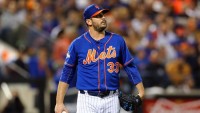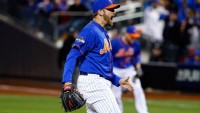Addison Reed
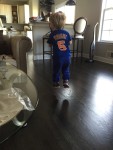
The season has gotten off to a rocky start and increasingly, it is becoming apparent that there are two types of Mets fans – Optimistic and Pessimistic. Here’s the breakdown:
Optimistic: the Mets won in 1969 and 1986. They win in years which have a 6 in them. It’s 2016!
Pessimistic: Tell that to the 1962 – 1968 Mets and the 1976 Mets. Also, someone probably should’ve told that to Carlos Beltran when he didn’t swing the bat.
Optimistic: The ’86 Mets began the year 2-3, and they lost two games to the Phillies.
Pessimistic: The 1992 Mets were also a high profile team people thought were World Series contenders that opened the year 2-3. By the way, the 1986 Phillies were a decent team. The 2016 Phillies are horrendous.
Optimistic: Yoenis Cespedes seemed to get off the snide. He went 2-4 with a homerun and two RBI.
Pessimistic: He’s still batting only .200, and did you see him drop that ball in Kansas City?
Optimistic: The Mets have the best ERA in baseball.
Pessimistic: Matt Harvey has been terrible. It’s only a matter of time before we discover Jacob deGrom needs surgery or he will be out half the year. By the way, the Mets have the best ERA, faced an awful Phillies team, and they’re still under .500.
Optimistic: The bullpen has been off to a terrific start.
Pessimistic: You must’ve missed yesterday’s game when Addison Reed melted down like it was Game 5 of the World Series.
Optimistic: David Wright has looked good to start the year.
Pessimistic: His throws have been terrible, and he’s already had to miss a game.
Optimistic: Neil Walker and Asdrubal Cabrera have looked great up the middle.
Pessimistic: Anything would’ve been an upgrade. By the way, they’re not hitting, and it hasn’t translated to wins. Speaking of wins, the Nationals are 3-1. Coincidentally, they have Daniel Murphy, the guy who carried the Mets in the postseason, is a National. He’s hitting .462/.611/.923.
Optimistic: This team is built to win the World Series, and I’m going to enjoy every single part of the ride.
Pessimistic: I don’t know what team you’re watching.
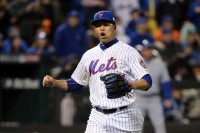
This time of year we get announcements that seem like news. When they’re said, it had to be covered because it is the team making an announcement. For example, when the Arizona Diamondbacks announced Zack Greinke as their Opening Day starter, it was met with a collective eye roll.
I felt the same way when the Mets announced Hansel Robles would most likely make the Opening Day roster.
Of course he is. Robles kept getting better and better last year. In the second half, he pitched 31.1 innings in 31 appearances. He had a 3.16 ERA with a 0.894 WHIP and a 12.1 K/9. He limited batters to a .171/.246/.450 batting line. Over the whole year, he showed an ability to get both righties and lefties out.
The issue isn’t whether Robles will be on the Opening Day roster. It should be what his role should be. Robles should be given the eighth inning.
Right now, that spot is being given to Addison Reed. For his career, Reed has a 4.01 ERA, 1.261 WHIP, and a 9.3 K/9. Like Robles, he is effective against righties and lefties. However, his performance is typically uneven over the course of a year.
The other option is newly signed Antonio Bastardo. In his career, he has a 3.58 ERA, 1.198 WHIP, and an 11.0 K/9. Although he’s a left, he shares Robles’ and Reed’s ability to get both righties and lefties out. The one caution with Bastardo is he seems to be an every other year player. Following his ERAs, his ERA is around 4.00 in even numbered years, and it is under 3.00 in odd numbers years. His ERA+ in those years support the every other year scenario. We’re heading into the 2016 season.
Just judging on the statistics, Robles should pitch the eighth inning. However, 31 appearances is a very small sample size to make such a judgment. It’s even more so when you consider that you’re moving him ahead of two established relievers the Mets are paying quite well. There’s so thing else to consider, Robles has dominating stuff.
Robles repertoire includes a 96 MPH fastball, 87 MPH change, and an 88 MPH slider. Each one of these pitches became more effective as Robles learned how to incorporate the quick pitch. That quick pitch is another reason why Robles should pitch the eighth.
Jeurys Familia also likes to use the quick pitch. It’s come to the point that batters are aware that he’ll do it. They have to come prepared each and ever at bat. Same goes for when Robles is on the mound. The Phillies will tell you that goes doubly for Familia.
However, it’s one thing to prepare for it. It’s a whole other thing to have seen it in an earlier at bat. If Robles comes in during the sixth or seventh inning, he’s bound to use the quick pitch. He needs to use it to be his most effective. Whether or not Familia needs it is a whole other question all together. He likes using it.
A batter having seen the quick pitch in a game is bound to be more prepared for it later in the game. The batter will be most prepared for it when the game is on the line. With that said, why let these batters be better prepared to face Familia’s quick pitch? The Mets shouldn’t. Instead, the Mets should keep Robles and Familia as close together as possible.
Robles has the stuff. He has the results. It’s better for Familia. Robles should pitch the eighth in 2016.
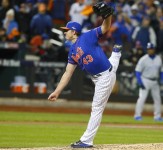
Pitchers and catchers have already reported, and the reporting date for position players is soon approaching. While everyone is settling in, the Mets coaching staff is already trying to plan out the 2016 season:
The Mets have Addison Reed penciled in as the eighth-inning guy to begin the season, according to pitching coach Dan Warthen.
— Mike Puma (@NYPost_Mets) February 20, 2016
Judging on his performance in his limited time with the Mets last year, Addison Reed was lights out. In 17 appearances, he had a 1.17 ERA, a 1.043 WHIP, a 2.74 FIP, an impossibly high 322 ERA+, and a 10.0 K/9. Between his performance, and his history of being an effective closer, Reed is a natural choice to take over eighth inning duties.
However, it should be noted that performance was uncharacteristically good for Reed. In his career, Reed has a 4.01 ERA, 1.261 WHIP, 3.41 FIP, 102 ERA+, and a 9.3 K/9. Accordingly, even if Reed benefitted from working with the Mets coaching staff, he would still be due for a regression back to the numbers he’s accumulated over his five year career. What’s interesting is that looking over Reed’s career, we may be able to see when it’s coming. Here is his ERA and WHIP by each month of his career:
- March/April 2.52 ERA & 1.195 WHIP
- May 4.74 ERA & 1.260 WHIP
- June 5.90 ERA & 1.336 WHIP
- July 3.66 ERA & 1.156 WHIP
- August 2.08 ERA & 1.049 WHIP
- September/October 5.21 ERA & 1.543 WHIP
Reed seems to be at his best at the beginning of the year and after the All Star Break. He tends to wear down after the breaks and with increased use. Last year was an exception. He actually had a very good September. It was perhaps the best month of his career. He had it in a pennant race. He did it with a new team.
So yes, it’s possible that Reed has figured something out, and now, he can be more consistent during the year. He did work on adding a splitter to his repertoire last year. Maybe the Mets were able to help get the most out of him. It’s possible he rose to the challenge that was presented to him. It’s more likely that Reed will put up similar numbers to those he has put up during the majority of his career.
If that’s the case, Reed will start out great and then regress. If that happens, fans should be patient with him. From his career, we can see that he will turn things around. He will be re-energized after the All Star Break. He has shown the ability to pitch well in a pennant race.
Whether or not Reed lasts the year as the eighth inning guy is inconsequential. What matters is that he is effective when it counts most. Judging from his career, 2016 is going to be a bumpy ride. However, fans should be patient with him. He’s shown us that he can produce when it counts most. At the end of the day, that’s all we want.
So with that said, Mets fans should be patient with him. If 2015 is any measure, he will reward that patience.
One of the fun things about Spring Training is the guy who plays so well, he forces his way onto the Opening Day roster.
In 1996, Butch Huskey hit nine homeruns in the Spring forcing the Mets to make him the Opening Day rightfielder even though he never previously played the position. In 2004, Tyler Yates had a 0.64 Spring Training ERA to get the fifth starter’s job. Yates beat out bigger Mets prospects like Aaron Heilman and Grant Roberts.
These players weren’t even darkhorse candidates to win the positions they ultimately attained on the Opening Day roster. Yet, they were able to win their jobs because they were that good in the Spring. More importantly, the Mets had a spot for these players. The Mets were held competitors for these positions, and these players performed so well that the Mets had no choice but to give them the job.
Looking over the 2016 Mets, there’s only one spot up for competition, and that’s in the bullpen. Right now with Jeurys Familia, Addison Reed, Antonio Bastardo, Jerry Blevins, and Hansel Robles, there are two spots up for grab. The names you’re apt to hear are Sean Gilmartin, Logan Verrett, and Erik Goeddel. Each pitched well out of the bullpen last year and deserve consideration.
Another name that deserves consideration is Jim Henderson.
If you don’t recognize the name, it’s understandable. He’s only pitched in 14 games in the majors the last two years due to a shoulder injury and subsequent surgery. Those 14 games were two years ago when he registered a 7.15 ERA. With all that said, Henderson should not be disregarded. He has a legitimate shot at making the Mets Opening Day roster.
Prior to the shoulder injury, Henderson was a very good reliever. Between 2012 and 2013, he made 97 appearances. He had a 2.98 ERA, 1.180 WHIP, 3.03 FIP, 133 ERA+, and 11.9 K/9. He only allowed 0.9 HR/9. In 2013, when the Brewers made him the closer, he recorded 28 saves.
He can help the Mets. Now that he has completed his rehab, he has a fastball that can touch 95 MPH. He knows how to strike guys out. For his career, he has just dominated righties. He has limited them to .183/.241/.284. At a minimum, he can be a specialist to get out tough right handed batters. Ideally, he can be the Chad Bradford to Blevins’ Pedro Feliciano. In order for that to happen, he just needs to get an opportunity.
Fortunately for him, Terry Collins seems like he is going to give Henderson a legitimate shot. As he told Anthony DiComo of MLB.com:
His history is very intriguing. I know he’s a couple of years out of sugery now, which we’re hoping makes a big difference. I saw him inMilwaukee, and he was very, very good. I’m just hoping we can catch lightening in a bottle.
It’s fair to say, Henderson has impressed Collins. It’s half the battle. All Henderson has to do now is go out there and perform this Spring Training. Like Huskey and Yates, he has to dominate in the Spring. He has to give the Mets no choice but to put him on the roster.
Editor’s Note: this article also appeared on metsmerizedonline.com
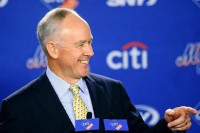
Here’s a question for you. If you had a GM that gave a bad contract to a 35 year old, forfeiting a pick in the process, and depleted it’s farm system of its top end starting pitching prospects for rentals, what would you call that GM? Apparently, you call Sandy Alderson the Executive of the Year.
Before proceeding, I’d like to note Alderson has generally done a good job with the Mets. The R.A. Dickey trade was a stroke of genius. However, that happened three years ago, and this is a 2015 award.
Alderson made two major league free agent signings for the 2015 season. The first was Michael Cuddyer. It was immediately panned by everyone. Alderson was out-maneuvered there by the Rockies of all organizations. With the Mets all but declaring they were signing David Wright‘s friend, the Rockies gave Cuddyer a qualifying offer. The Mets then gave Cuddyer a two year $21 million contract. Cuddyer was hurt, and he regressed as 35 year old players do. He’s now a $12.5 million bench player.
The other free agent deal was John Mayberry, Jr. Mayberry hit .164/.227/.318. He was released at the end of July. Overall, Alderson’s free agent acquisitions were complete busts.
His trades weren’t much better. Do you realize for a team touted with organizational starting pitching depth, Alderson depleted much of it. He traded eight minor league arms in total. For all the pitchers that were traded, Addison Reed is the only player the Mets could keep in 2016. By the way, Reed is a non-tender candidate.
Yes, the Mets made the World Series. They also lost it. For all the moves and sacrificing the future, the Mets still fell short. Further, it does not appear the moves generated enough revenue to sufficiently increase payroll. In the end, the Mets have up two big pitching prospects for rentals. If you’re saying it was worth it, I ask you if John Smoltz was worth it?
In 1987, Smoltz was traded for Doyle Alexander. Alexander went 9-0 with a 1.53 ERA for the Tigers. His fantastic run certainly mirrors the run Yoenis Cespedes had this year. Like the Mets, the Tigers won their division. Like the Mets, the Tigers didn’t win the World Series. The Tigers lost out on a Hall of Fame career. Time will only tell with Michael Fulmer. However, we do know he’s a highly rated prospect the Tigers believe can contribute very soon.
It’s the reason I said it was a bad trade from the beginning. It’s even worse when you consider the Tigers had to trade Cespedes because they were about to lose him for nothing.
Then there’s the issue of giving up another well regarded prospect in Casey Meisner for Tyler Clippard. Clippard was a rental. Yes, Clippard was terrific early on with the Mets, and he helped the Mets win the division. Addison Reed was even better, and the Mets obtained him for much less. Again, this was a bad trade.
No, Alderson won this award for his earlier work and the system built by Omar Minaya. Alderson weakened the farm system in 2015, and he may now need to trade away major league talent rather than minor leaguers to improve the team in 2016. After all his moves, the Mets still don’t have a shortstop. There may also be new holes in center and at second.
Alderson has had a good run here, but he was not good in 2015. He certainly wasn’t the best executive in 2015. Unfortunately, this should bear out in the oncoming years.
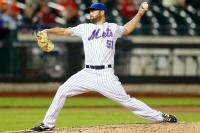
As the Mets are trying to make room on the 40 man roster to protect players from the Rule 5 Draft, there was always going to be a chance they’d expose someone valuable.
During this process, the Mets removed Jack Leathersich from the 40 man roster exposing him to waivers. It was certainly understandable considering he had Tommy John surgery in June meaning he probably won’t be able to pitch next year. It should be noted if the Mets wanted to keep Leathersich, they had to remove him from the 60 day DL and put him on the roster.
Not adding Leathersich back to the 40 man roster was a risk. It was a calculated risk. First, why would another team clog up a spot on the 40 man roster for a LOOGY who won’t pitch next year. Second, if you had him on the team next year, you’d have to put him on the 60 day DL next year. This would mean a higher salary for Leathersich and more MLB service time that the Mets will not benefit the Mets on the field. Finally, the Mets have plenty of bullpen options to get lefties out next year.
Next year, the Mets will have Dario Alvarez ready to go. Josh Smoker was just added to the 40 man roster. Josh Edgin is due to return from his own Tommy John surgery next year. The projected main setup men, Addison Reed and Hansel Robles, get lefties out and do not need a LOOGY to bail them out. This is all before the Mets possibly adding a LOOGY in free agency. Therefore, if you’re opening up a spot on the 40 man roster you look towards the LOOGY that won’t pitch next year. It’s a gamble, but it’s one worth taking.
Unfortunately, the Cubs claimed Learhersich. More power to them if they can carry an injured LOOGY on their 40 man roster for a full season. It wasn’t practical for the Mets to do it. It’s not practical for most teams. Sure, I could point to other players that should be removed, but truth be told they’ll be removed eventually to protect a player from the Rule 5 draft or to make room for a free agent.
The Mets made the right move here. Sometimes even when you make the right move, you’re going to get jacked.
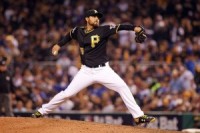
Unsurprisingly, the Mets have interest in both Darren O’Day and Joakim Soria. If you’re looking for an elite setup guy, you’re going to be interested in both players.
Soria is now three years removed from Tommy John surgery. In the four seasons prior to the one he was injured, Soria was an elite closer recording 132 saves with a 2.03 ERA and a 0.988 WHIP. He got injured, and he became a different player. Still a good closer/reliever, but not an elite closer.
After coming back from surgery, he went to Texas where he recorded 17 saves with a 3.16 ERA and a 1.043 WHIP in two years. He then signed with the Tigers, who seem desperate for relief help every year (sound familiar?). In two years, he recorded 24 saves with a 3.29 ERA and s 1.115 WHIP. When he was traded to the Pirates, he was terrific in the bullpen because he’s a good pitcher and everyone is terrific in the Pirates bullpen. In 29 games he had a 2.03 ERA with a 1.163 WHIP.
With the Mets seeking an eighth inning reliever, Soria would be an upgrade over Addison Reed, who has a career 4.01 ERA and a 1.261 career WHIP. Soria is a huge upgrade. Soria is expected to receive a 2 year $14 million contract or $7 million per season. Reed is slated to receive $5.7 million in arbitration. Soria would be worth the $1.3 million increase.
O’Day appears like he will command a 3 year $21 million contract or $7 million per year. While I think the $7 million per year on both O’Day and Soria are fair estimates, the increased interest may bump those numbers up to around $8 million per season.
Right now, the Mets projected payroll is around $92 million with about $18 million left in the budget. Would it be wise to blow almost all of it on relievers? I think so. The current free agent market lacks the elite second base, shortstop, or center fielders who would improve the Mets offense. The Mets don’t seem inclined to bring back Daniel Murphy.
The best solution might be to create an absolute shut down pitching staff. Going from the Mets elite starters to O’Day-Soria-Jeurys Familia will hold up any lead the Mets can muster. Also, keep in mind, the Mets will have full years from David Wright, Michael Conforto, and Travis d’Arnaud, which should offset the losses of Murphy and Yoenis Cespedes.
The Mets best approach to this offseason might be to create a shutdown bullpen to match their starting pitching. Bring on both O’Day and Soria.
